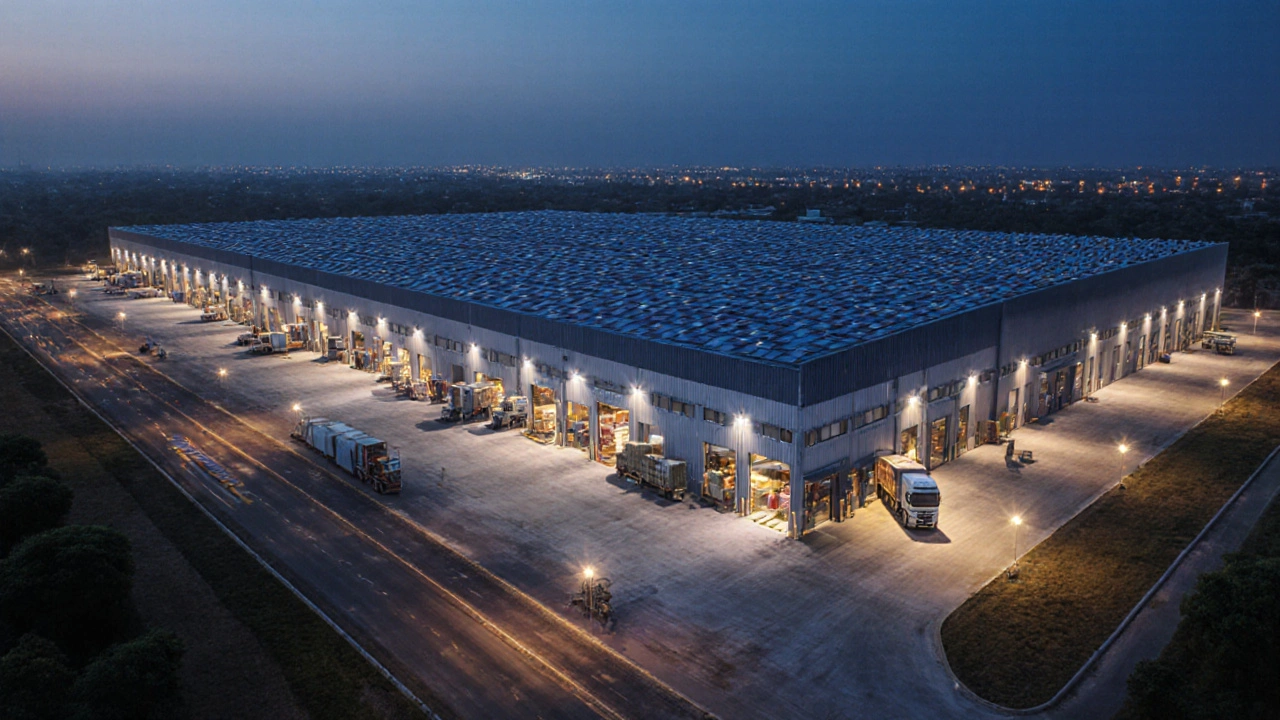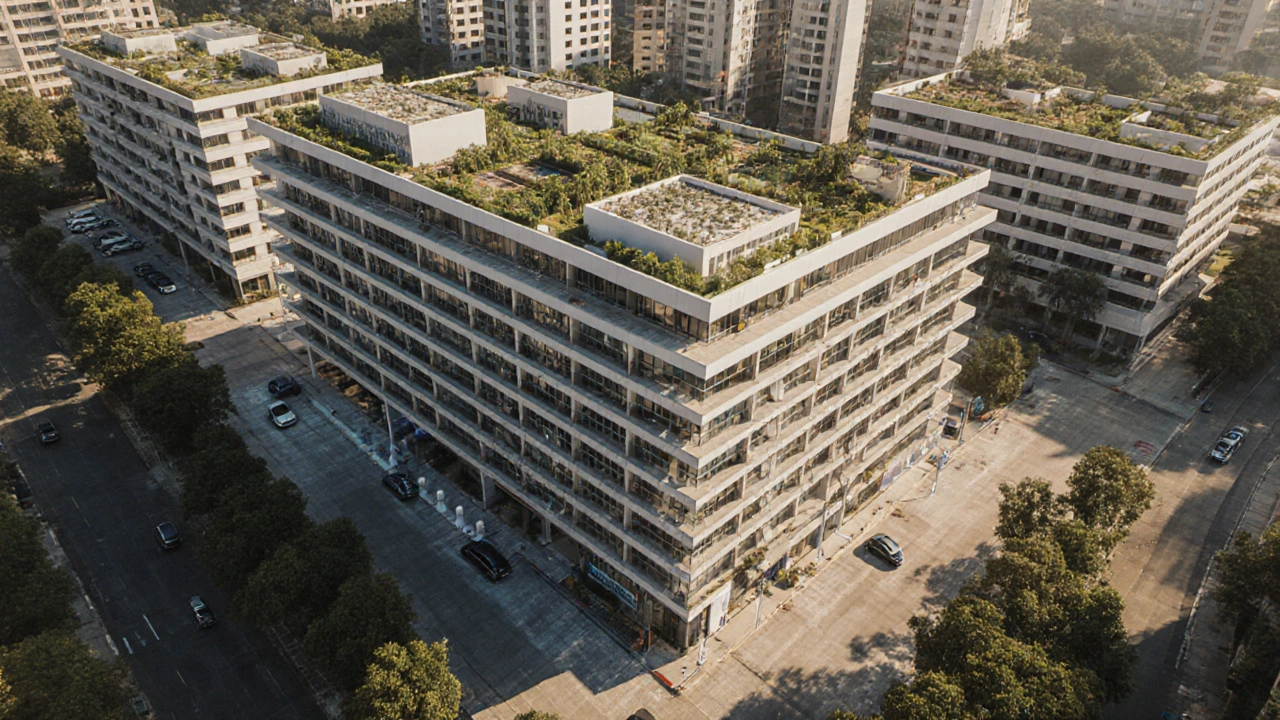Delhi’s commercial real estate market isn’t just growing-it’s reshaping how businesses operate across North India. If you’re thinking about leasing or buying office space, retail outlets, or warehouse units here, you need to know where the money’s actually moving in 2025. This isn’t about flashy brochures or generic advice. It’s about what’s happening on the ground, in the neighborhoods, and in the contracts being signed right now.
Where Commercial Real Estate Is Actually Growing in Delhi
Most people think of Connaught Place or South Delhi when they hear "commercial real estate in Delhi." But those areas are saturated. Rents there are sky-high, and vacancy rates for new builds are creeping up because tenants are looking elsewhere for better value.
The real action is in Gurgaon (Gurugram), Noida, and now, increasingly, in the East Delhi corridor-especially around Rohini, Dilshad Garden, and the upcoming Delhi-Meerut Expressway exits. These zones are seeing a surge in demand from mid-sized firms, logistics companies, and startups that need space but can’t afford premium prices in the old hubs.
Take Noida’s Sector 126. In 2023, average office rental rates were ₹85 per sq. ft. By mid-2025, they’ve climbed to ₹115 per sq. ft. But here’s the catch: in Rohini, the same space costs ₹65-75 per sq. ft. with new, modern buildings and better connectivity via the Delhi Metro’s Pink Line extension. Companies are moving because the math adds up.
Office Space: What’s Actually in Demand
Open-plan offices are out. Flexible, hybrid-ready spaces are in. Tenants now want options: private pods for focused work, soundproof meeting rooms, on-site cafeterias, and high-speed fiber internet that doesn’t drop during Zoom calls. Landlords who still offer basic, windowless cubicle farms are struggling to fill space.
Companies like Zomato, Byju’s, and several fintech startups are signing 3-5 year leases in integrated business parks that include EV charging stations, rooftop gardens, and 24/7 security. These aren’t luxuries anymore-they’re table stakes. A 2024 survey by CBRE India found that 78% of businesses in Delhi prioritized employee wellness features over lower rent.
If you’re buying, look for buildings with LEED Gold or IGBC certification. They command 12-18% higher rental premiums and have lower operating costs thanks to energy-efficient HVAC and lighting systems. A 10,000 sq. ft. certified building in Gurgaon might cost ₹1.2 crore more upfront, but saves ₹18-22 lakh annually in utilities.
Retail Space: The Death of Malls and Rise of Community Hubs
Large, isolated shopping malls are losing ground. In their place: neighborhood retail clusters. Think small plazas with 5-10 units, anchored by a pharmacy, a grocery store, and a coffee shop. These are popping up in residential pockets like Dwarka, Pitampura, and Faridabad.
Why? Because consumers want convenience. A 2025 report by JLL India showed that 63% of Delhi residents prefer shopping within a 5-km radius. Big brands like Reliance Retail and Tata Cliq are shifting from standalone flagship stores to smaller, high-frequency outlets in these clusters. A 500 sq. ft. unit in a well-located neighborhood plaza now rents for ₹80-100 per sq. ft.-higher than some spaces in older malls.
Don’t overlook the rise of hybrid retail. Stores that combine pickup points for e-commerce orders with a small showroom are thriving. A single unit in Gurgaon’s Sector 29 now doubles as a pickup hub for Amazon and a retail counter for a local fashion brand. Landlords are starting to design units with dual entrances and separate delivery zones to accommodate this trend.

Warehousing and Logistics: The Hidden Goldmine
If you think commercial real estate in Delhi is only about offices and shops, you’re missing the biggest growth sector: logistics. With e-commerce growing at 22% annually in India, and Delhi being the largest consumer market in North India, warehousing demand is exploding.
Areas like Sahibabad, Ghaziabad, and the Delhi-NCR logistics corridor near the Kundli-Manesar-Palwal (KMP) Expressway are seeing rapid development. Modern, automated warehouses with 12-15 meter clear heights, dock-level loading, and solar rooftops are leasing out in under 30 days. Rents for Grade A warehouses have jumped from ₹45 per sq. ft. in 2022 to ₹82 per sq. ft. in 2025.
One investor bought a 50,000 sq. ft. warehouse in Sahibabad in 2023 for ₹18 crore. Today, it’s valued at ₹34 crore. Why? Because it’s within 15 km of the Delhi Airport’s cargo terminal and has direct access to the expressway. That proximity to transport nodes is worth more than the building itself.
What’s Driving Prices Right Now
Three things are pushing commercial real estate prices up in Delhi: infrastructure, policy, and demand.
First, infrastructure. The Delhi Metro’s expansion into Noida and Ghaziabad, the completion of the Rapid Rail Corridor connecting Delhi to Sonipat, and the upcoming Delhi-Meerut Expressway are slashing commute times. That means businesses can afford to locate further out-without losing talent.
Second, policy. The Delhi government’s 2024 Industrial Policy offers tax breaks for businesses setting up in designated industrial zones. If you lease or buy in a notified area like the Okhla Industrial Area or the Greater Noida West Industrial Corridor, you can get up to 75% stamp duty waiver for five years.
Third, demand. Corporate relocations from Mumbai and Bengaluru are accelerating. Companies are moving to Delhi for access to a larger talent pool, lower operational costs, and better connectivity to North Indian markets. A single mid-sized IT firm relocating from Bangalore to Noida can bring in 300+ employees-and all need space.

Red Flags to Watch Out For
Not every deal is worth signing. Here’s what to avoid:
- Properties without clear title deeds-Delhi has a long history of disputed land ownership. Always verify with the Delhi Sub-Registrar Office.
- Buildings with poor water and power backup-load-shedding still happens in parts of East Delhi. Ask for 12-hour generator backup and RO water systems.
- Leases with no exit clauses-if your business shrinks or relocates, you need to get out. Avoid 10-year leases without break options.
- Landlords who don’t maintain common areas-dirty lobbies, broken elevators, and unlit parking lots signal neglect. That’s a red flag for long-term value.
Also, avoid "guaranteed returns" schemes. Some developers promise 10-12% annual returns on commercial property. Those are usually based on inflated rental projections. Realistic yields in Delhi’s prime zones are 5-7%. In emerging areas, they’re 6-8%.
Who Should Invest-and Who Should Wait
If you’re a business owner looking to own your space, 2025 is a strong time to buy. Interest rates are stable, and prices in emerging zones are still below their peak. Owning your office or warehouse gives you control over upgrades, branding, and long-term costs.
If you’re a passive investor, focus on logistics parks or neighborhood retail clusters. These have steady tenant demand and lower vacancy risk. Avoid speculative buys in unproven locations just because a metro line is "planned." Wait until construction starts.
For startups and small businesses, renting remains the smart move. Lock in 2-3 year leases with options to renew. Don’t tie up capital in property until your business is consistently profitable.
Where to Look Next
Keep an eye on:
- Yamuna Expressway Industrial Corridor-new warehouses and light manufacturing units are being built here with direct highway access.
- Delhi-Noida Direct Flyway-connects South Delhi to Noida in under 20 minutes. Commercial zones along this route are heating up.
- East Delhi’s Okhla Industrial Area-being redeveloped with modern facilities. Government incentives are drawing new tenants.
These aren’t whispers. They’re happening. The Delhi Development Authority has already approved master plans for these zones. If you’re waiting for a "perfect moment," you’ll miss it. The best deals are going fast.
Is commercial real estate in Delhi a good investment in 2025?
Yes-if you focus on the right areas. Logistics hubs, neighborhood retail clusters, and modern office parks in Noida, Gurgaon, and East Delhi are delivering strong returns. Avoid overpriced, saturated zones like Connaught Place. Real yields are 5-8%, and demand is rising due to infrastructure growth and corporate relocations.
What’s the average rent for office space in Delhi?
Rents vary widely. In Connaught Place or South Delhi, expect ₹150-200 per sq. ft. In emerging areas like Rohini or Noida Sector 126, it’s ₹75-115 per sq. ft. Modern, certified buildings command 15-20% more. Always verify if the rate includes maintenance and utilities.
Can foreigners buy commercial property in Delhi?
Yes, but only under certain conditions. Foreign nationals and companies can buy commercial property in Delhi if they’re registered with the Reserve Bank of India and the property is used for business purposes. Residential property is restricted, but commercial is allowed with proper documentation and approval.
How do I verify a property’s title in Delhi?
Visit the Delhi Sub-Registrar Office with the property’s document number. You can also request a certified copy of the title deed and check for encumbrances through the Delhi Land Records portal. Always hire a local property lawyer to review documents before signing any agreement.
Are there tax benefits for buying commercial property in Delhi?
Yes. The Delhi government offers up to 75% stamp duty waiver for commercial properties in notified industrial zones. You can also claim depreciation at 5% annually on the building value under income tax rules. Consult a chartered accountant to structure your purchase for maximum tax efficiency.

10 Responses
They don't want you to know this but the whole Delhi commercial boom is being pushed by foreign funds buying up land under shell companies. Look at the land records in Noida Sector 126 - half the plots are owned by firms registered in the Caymans. The government’s 'tax breaks'? Just a smokescreen to let outsiders loot the market. And don’t get me started on the metro extensions - they’re not for us, they’re for corporate evacuations from Mumbai. We’re being played.
so i was just reading this and like… i think the part about retail clusters is spot on? i mean i live in pitampura and there’s this tiny plaza with a pharmacy and a chai stall and a small fashion shop and it’s always packed? like why do people drive 10km to a mall when they can grab groceries and coffee in 5 mins? also i think the part about hybrid retail is kinda underplayed? like my cousin runs a small brand and they use one unit as a pickup spot for amazon orders and sell their own stuff too and it’s working way better than their old store in saket? also sorry for typos i’m typing on my phone and also i think the part about warehouse near kmp is wild because my uncle’s friend bought one and now he’s like a millionaire? idk just saying
This is one of the most practical, grounded takes on Delhi’s commercial real estate I’ve read in a long time. The emphasis on employee wellness features and certified buildings isn’t just trendy - it’s smart business. I’ve seen companies move out of South Delhi because their teams were burning out in windowless cubicles, and the jump in productivity after switching to a LEED-certified space in Gurgaon was undeniable. The data on logistics is especially compelling. If you’re looking for stable, long-term returns, warehouses are the quiet winner here.
Thank you for sharing this information in such a clear way. It is helpful to understand where the real growth is happening, and not just where people think it is. The point about avoiding leases without exit clauses is very important. Many small businesses do not realize how much risk they take when they sign long contracts. I also agree that checking title deeds is necessary. Safety comes first.
Interesting. You mentioned that 78% of businesses prioritize wellness features over rent. But what’s the actual data source? CBRE India’s 2024 survey - is that publicly available? I’d like to see the sample size and which cities were included. Also, how many of those companies are actually in Delhi versus just surveyed remotely? Curious because sometimes surveys get inflated to push certain narratives.
If you’re a startup or small business owner reading this, listen up. Don’t wait for the perfect moment - start small. A 500 sq ft hybrid retail unit in Dwarka or Rohini can be your foot in the door. You don’t need to own it. Rent it. Test the market. Build your brand. Then scale. I’ve helped three local entrepreneurs do exactly this over the last year. One turned a ₹40k/month rent into a ₹3L/month business. It’s not magic. It’s strategy. And the time to act is now - not next year.
Agree with the logistics point. I’ve been watching Sahibabad for a while. The warehouse I visited last month had solar panels, automated loading, and was 95% occupied. The guy leasing it said he had 12 inquiries before the sign even went up. And the kicker? He didn’t even advertise. Word of mouth in this space is insane. Also, the Delhi-Meerut Expressway exits are going to be huge. I’ve seen plots near Dasna getting snapped up by logistics firms. If you’re looking for value, that’s the next frontier.
The shift from malls to neighborhood retail clusters reflects a deeper change in consumer behavior. Convenience is no longer a luxury - it is a baseline expectation. The data from JLL supports this, and the trend is consistent across tier-two cities as well. Investors who recognize this structural shift will benefit. Patience and precision matter more than speed.
I just moved my clinic to Rohini last year. The rent was half of what I paid in South Delhi and the space is brighter, cleaner, and has better parking. My patients notice. I didn’t think it would work, but it did. Sometimes the smartest move is the quiet one.
OMG this is so true!! I just saw a warehouse in Ghaziabad that had a rooftop garden AND EV chargers AND a 24/7 security guard who waved at me like we were neighbors?? Like who even does that?? And the rent? Less than what my cousin pays for a 100 sq ft studio in Connaught Place!! I’m not even in real estate but I want to buy one now!! This is the future and it’s here and it’s wild and I’m obsessed!!